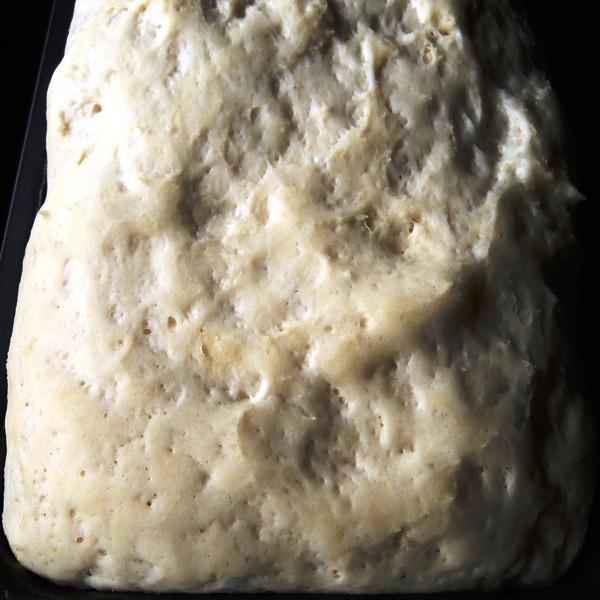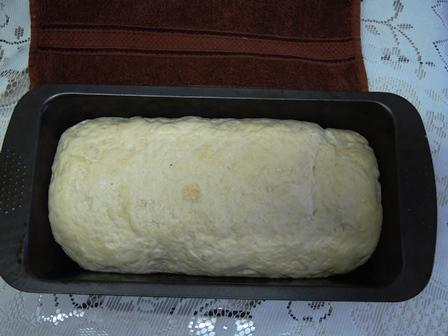Bread rise more quickly, batter and dough method
 Make bread rise in one hour instead of four hours. Sorry for the long silence as I have been working on how to make bread rise more and quickly ever since I made the garlic bread. It really bugged me to see how much the garlic bread rose within the four hours. I know that certain additives can be used to make bread rise a lot but to find a bread flour that didn’t require additives and that would rise a lot knocked me off my feet. I know of the standard method of letting the dough rise in the oven with the pilot light on. The warmth of the pilot light brings up the temperature to point that is conducive for the growth of yeast. Those methods were not good enough for me. So I went back to the drawing board and re-looked at the whole process. 5 to 6 experiments later I had solved most of the issues relating to making bread rise more and quickly.
Make bread rise in one hour instead of four hours. Sorry for the long silence as I have been working on how to make bread rise more and quickly ever since I made the garlic bread. It really bugged me to see how much the garlic bread rose within the four hours. I know that certain additives can be used to make bread rise a lot but to find a bread flour that didn’t require additives and that would rise a lot knocked me off my feet. I know of the standard method of letting the dough rise in the oven with the pilot light on. The warmth of the pilot light brings up the temperature to point that is conducive for the growth of yeast. Those methods were not good enough for me. So I went back to the drawing board and re-looked at the whole process. 5 to 6 experiments later I had solved most of the issues relating to making bread rise more and quickly.
Bread rise more using kitchen technology
After carrying out some research on the internet I found out that the enzyme Amylase could be used to make bread rise more. Where do I get amylase? Not in Kuala Lumpur or Petaling Jaya. Using amylase to make bread rise more and quickly was a dead end option. Then I thought if amylase breaks down starch into simple sugars, why don’t I add a simple sugar into my recipe? I added glucose into my bread recipes and found that worked darn well except it created a new problem. Adding glucose to make bread rise more also made the bread very rough. The bread had a very rough mouth feel. That means that glucose sped up the glutenisation of the bread, the gluten polymers became longer and gave the bread a horrible mouth feel.
So I had to abandoned the glucose enhanced bread experiments.
Then I examined the bread improvers. Somehow adding bread improvers never seemed to work with anything I tried. Then I figured out that the bread improvers are there on the supermarket shelves so that you learn how to improve your sense of patience and not to improve the bread. The one thing I do know is that bread improvers contain vitmain c. As I had a lot of powdered vitamin c for my liposomal vitmain c experiments I tried adding in vitamin c into my bread recipes. I found that adding vitamin c powder made the dough behave as if it had a lot of water. The bake times were longer. The 30 minute bake time resulted in slightly raw or undercooked dough in the center of the bread.
So I abandoned using vitamin c to make bread rise quickly.
I had to find a way that was simple and easy for home bread bakers to make bread rise a lot and quickly. Back to the drawing board once again. Bread rises due to the gasses released by the yeast. The gluten traps the gasses and the bread rises. Here was bread making 101 and the answer lay right here. What if the bread flour did not have sufficient gluten? What if standard bread recipes don’t call for enough yeast to make more gas quickly? So I tried both techniques and they worked together. When I tried extra yeast and sugar alone, the bread rose quickly, within one to two hours, but it always stopped at half an inch below the top of the baking tin just like any standard bread recipe. Examining the dough I could see tiny holes appearing on the dough surface that allowed the gasses to escape. That showed me that there was insufficient gluten in standard bread flour to make bread rise a lot.

The picture shows many tiny holes in the dough. Those holes allow the gases generated by the yeast to escape easily. I suspect that those holes are created when the dough stretches as there is insufficient gluten to form a strong network to hold the dough in one piece.
The final result was a quick bread and a simple technique to make bread rise a lot.
Make bread rise more with the Batter and Dough method – simple and easy bread recipe
| Bread Rise More Recipe | ||||
| Item | Ingredients | Percentage | Weight | Weight |
| (%) | (g) | oz. | ||
| 1 | Bread Flour for Batter | 10 | 40.00 | 1.41 |
| 2 | Bread Flour for Dough | 90 | 360.00 | 12.67 |
| Subtotal | 100 | 400 | 14.08 | |
| Batter | ||||
| 3 | Cold water | 67 | 268.00 | 9.43 |
| 4 | Sugar | 6 | 24.00 | 0.84 |
| 5 | Instant Yeast | 2 | 8.00 | 0.28 |
| Dough | ||||
| 6 | Salt | 1.5 | 6.00 | 0.21 |
| 7 | Butter | 7 | 28.00 | 0.99 |
| 8 | Gluten powder | 4 | 16.00 | 0.56 |
You will notice that in the recipe above, to make bread rise quickly, the gluten content is increased to 4%. I had tried 2% and 2.5% which was enough to make the bread rise quickly but not enough for the bread to rise more. You will notice that I have increased the sugar content. The sugar is for the yeast and not for our palate. The bread won’t taste sweet because the yeast would have gobbled up all the sugar.
Photos of how to make bread rise quickly with the Batter and Dough method

Make the batter with 10% of the bread flour, sugar, yeast and water. Allow it to rest for half an hour and not longer or the bread will have a rough mouth feel.

After half an hour the batter should look like this if you had left it alone.

Add the rest of the bread flour and stir for a few times to get the water into the flour then add the rest of the ingredients and mix.

Roll out the dough into a log shape and begin proofing in the greased baking tin.

After an hour the bread has rise to the normal height for a standard bread recipe. You can bake it at 230C (446F) for 30 minutes. Or you can wait another half an hour to 45 minutes for it to proof some more. With this recipe you can watch the bread rise slowly.

I allowed it to proof for 2 hours and it has almost overflowed the baking tin. You can see a large whole form on the left that allowed gases to escape. It just could not rise anymore. You will also notice that due to the extra gluten (4%) the tiny holes did not form in the dough after two hours of proofing allowing the bread rise to be speedy. bake for 20 to 25 minutes at 230C (446F).

You can see the bread did deflate a little when placed in the oven. I think this is some kind of heat shock, that is it tries to expand even more and the dough structure bursts allowing the trapped cases to escape. I think if you try to make bread rise more the dough structure thins and is easier to burst. So it is best to proof the bread for one and a half hours instead of two if you do not want it to deflate in the oven.
In the end I guess you can make bread rise more and quickly using extra gluten, sugar and yeast. By doing that, you do not need to proof for 4 hours. Isn’t that great? I will try to make the bread rise more with a little of vitamin c.
This article on quick bread rise more batter and dough method was researched and written by Peter Achutha
Leave a Reply